In the last days before the Year of the Dragon, I drove in and around the Tri-Cities to visit the new territory of the grocery tigers. Local chains have pounced on prime real estate outside of Vancouver to open their new stores. There, I glimpsed the future of Canadian supermarkets.
The Lunar New Year comes on the heels of Christmas. For Chinese Canadians who celebrate both, it’s a double whammy of cooking for two rounds of belly-bursting family dinners. Christmas calls for baking and roasting, while the new year switches to more steaming and braising. But before any work can start in the kitchen, there is a marathon of shopping to be done.
There is no shortage of places to hit up for Chinese groceries in Vancouver (Chinatown, Victoria Drive, First Avenue, etc.) or Richmond (do I really have to name them all?). But in the Tri-Cities, the options are fewer.
The old tiger here is none other than T&T Supermarket. Back in 2000, also a Year of the Dragon, the grocery chain was taking off, choosing to open at the Coquitlam Centre shopping mall for its eighth location, where it reigned as a dominant destination in those forested suburbs for East and Southeast Asian groceries.
Coquitlam did have its share of cosy Chinese supermarkets like Tung Fat and New Pacific to support the growing diaspora. But what it boasts are Korean options, supplied by the importers who have set up in nearby warehouses on the Fraser River. The popular Korean American grocery empire H Mart chose to open its first Canadian location in Coquitlam back in 2003. Homegrown chains like Hannam and Assi have held their own, with in-store aunties making colourful banchan and grab-and-go rolls of kimbap.
But as a pan-Asian grocery? T&T reigned, stocking everything from lemongrass to longanisa.
This year, though, I’m visiting because serious competition to the Loblaw-owned T&T has arrived. The other grocery tigers are big B.C. names looking to claim their chunk of the market.
They are none other than the Jim Pattison Group, known for Save-On-Foods and many other retailers, and the Georgia Main Food Group, operated by the long-standing H.Y. Louie Co. behind London Drugs, IGA in B.C. and Fresh St. Market.
In recent weeks, they opened their supermarkets with lion dances, flower wreaths and free gift cards, with more stores on the way. T&T, ahead of these arrivals, added a new Coquitlam location last year. Grocery Business magazine has likened the openings to a “duel,” though what’s on locals’ minds is not the competition but the excitement of having more options to hunt for groceries.
The new stores have a lot to say about immigration and population growth in the region, as well as supermarket strategy at a time of inclusivity and evolution of the Canadian diet.
There is a housing boom out here, but these stores are the cultural hubs that help the suburbs evolve into multi-ethnic metropolises of their own.
With this in mind, I hit the highway.
PriceSmart Foods
9899 Austin Rd., Burnaby
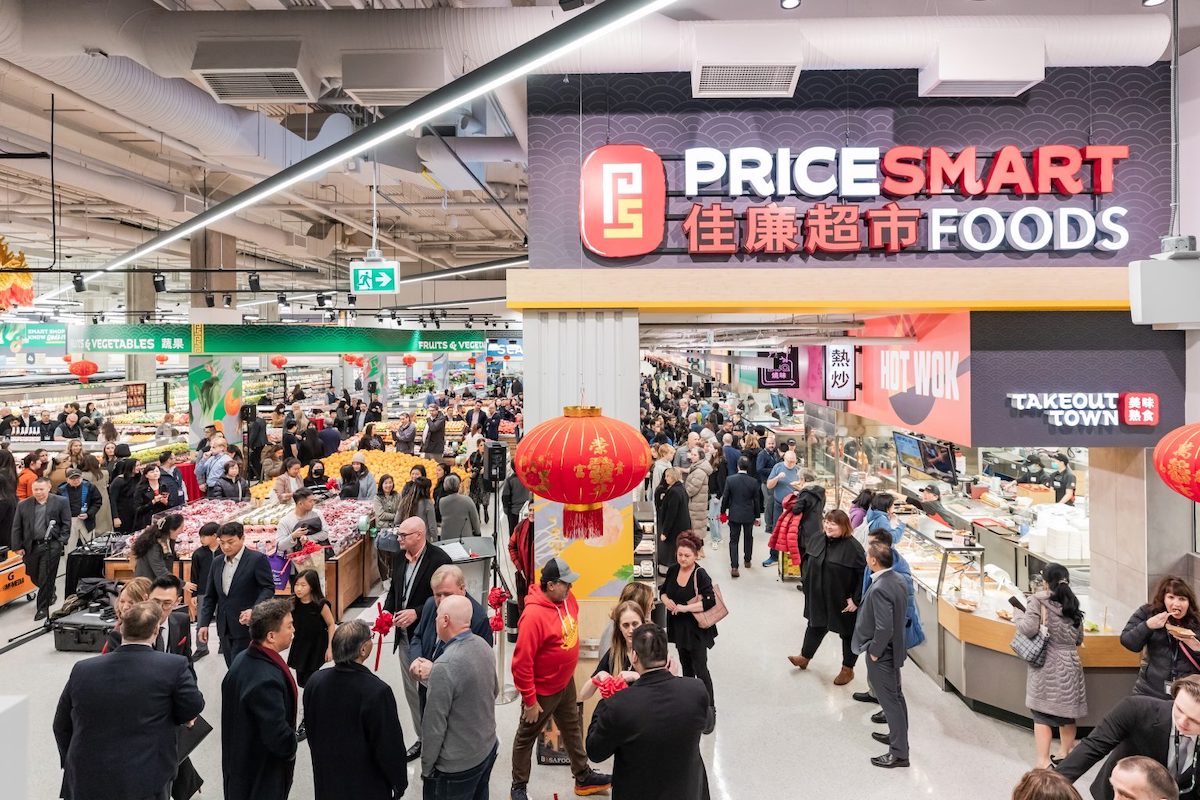
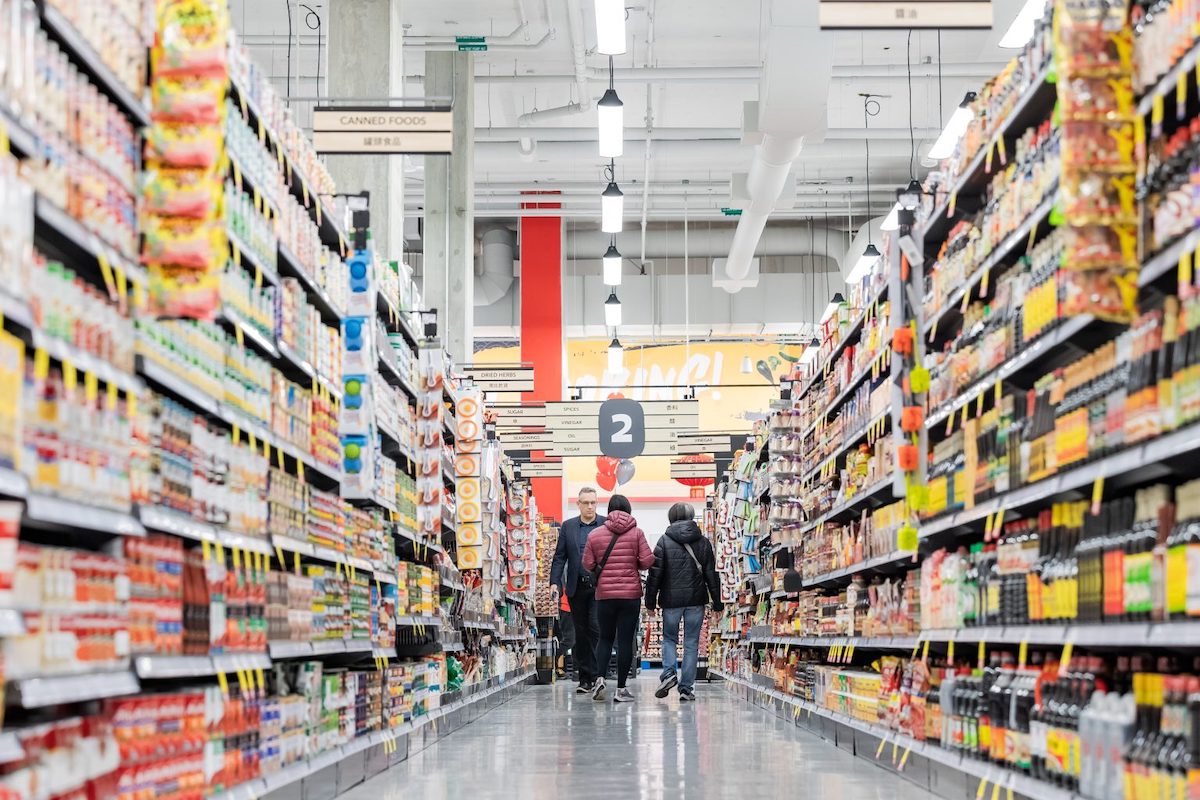
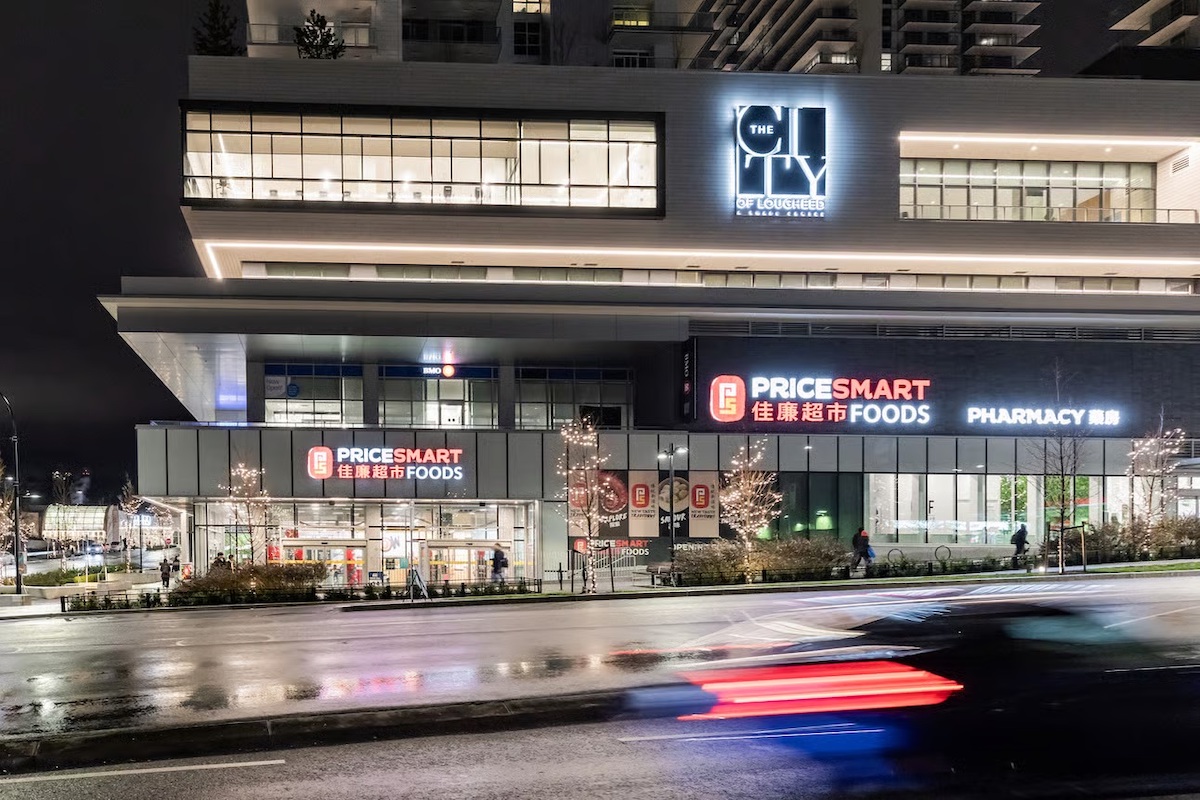
Everything is new at the budding City of Lougheed development: new sidewalks, new bike lanes, new storefronts for lease. Trees will soon be planted for the main boulevard. At the border of Burnaby and Coquitlam, there is more legroom to build, and the sheer scale rivals anything you might find in Vancouver. A tower proposed for the neighbourhood at 80 storeys, on what was once a little Sears outlet, could become the tallest structure west of Toronto.
Anchoring the verticality is a new East Asian supermarket from the Pattison group: PriceSmart Foods.
It’s an impressive cube of a space, slightly sunken from street level, lined on the edges with a bakery boasting Macanese egg tarts and Japanese milk loaves, a cosmetics section with hard-to-find overseas products, a seafood department with live fish and shellfish, a butcher with a wide assortment of cuts and a selection of bulgogi for the Korean crowd, and a long line of counters at the “Takeout Town” that evoke street stalls, selling ramen, skewers and Cantonese barbecue.
It’s already a hit with the students coming down from Simon Fraser University and the burly builders who have come down from the clouds, hungry after their work erecting the towers. On the mezzanine by the street entrance is an in-house café, overlooking the store and eventually the redevelopment of the old mall across the street. Underground, there is an awful lot of free parking for a development at the nexus of three SkyTrain lines in Burnaby.
Those unfamiliar with East Asian cooking might not understand the importance of supermarkets like these, why western ones like Safeway that happen to stock soy sauce won’t cut it. Adding soy sauce to a dish doesn’t necessarily make it “Asian.”
The veggies are different, not just species like bok choy and gai lan, but specifically cultivated carrots and genera of spinach unlike their western counterparts. The meat is different; the birds and fish have heads and tails. The cuts of pork chops and beefsteaks at western supermarkets don’t make the cut for East Asian dishes that call for something else. In the dried goods section, there are plants and seafood to be reconstituted for dishes, roots and fruits that go into teas and soups. The fresh ingredients are different too: tofu, not cheese; noodles, not pasta; dumplings, not Hamburger Helpers.
As you can tell, asking a western supermarket to be inclusive of such traditions means reimagining costly departments that require investment in specialized labour and equipment. And I haven’t even got into the building blocks required for the multitude of South Asian cuisines, from aromatics and flours to fats and sugars.
In overseas communities like Canada, diasporas have made do for decades without the complete set of ingredients by making creative substitutions. But thanks to well-stocked supermarkets like PriceSmart, milestones and holidays can be celebrated more fully and shared with new generations — even curious new audiences. PriceSmart’s new slogan reflects this: “New taste traditions.”
The grandeur of the opening — attended by Pattison group bigwigs and Burnaby politicians and serenaded with Adele songs by a guzheng player — might hide the fact that the brand has been around for over a decade.
In my circles, however, many people had no idea that PriceSmart was an Asian supermarket. It makes me wonder if that’s why the opening of this store was timed with the rebranding effort, dressing PriceSmart stores in red and gold colours, and ditching the old logo for a new one that looks like a Chinese seal. Another location is planned for Coquitlam Centre.
The first PriceSmart I ever went to in Richmond was a creative exercise in segregation under one roof. The red half of the store sold East Asian products, while the blue half of the store sold western products.
Nowadays, the sauces, snacks and spices have been regrouped in the shelves and aisles, breaking down the divisions as this vertical village comes to life.
Meiga Supermarket
221 Ioco Rd., Port Moody
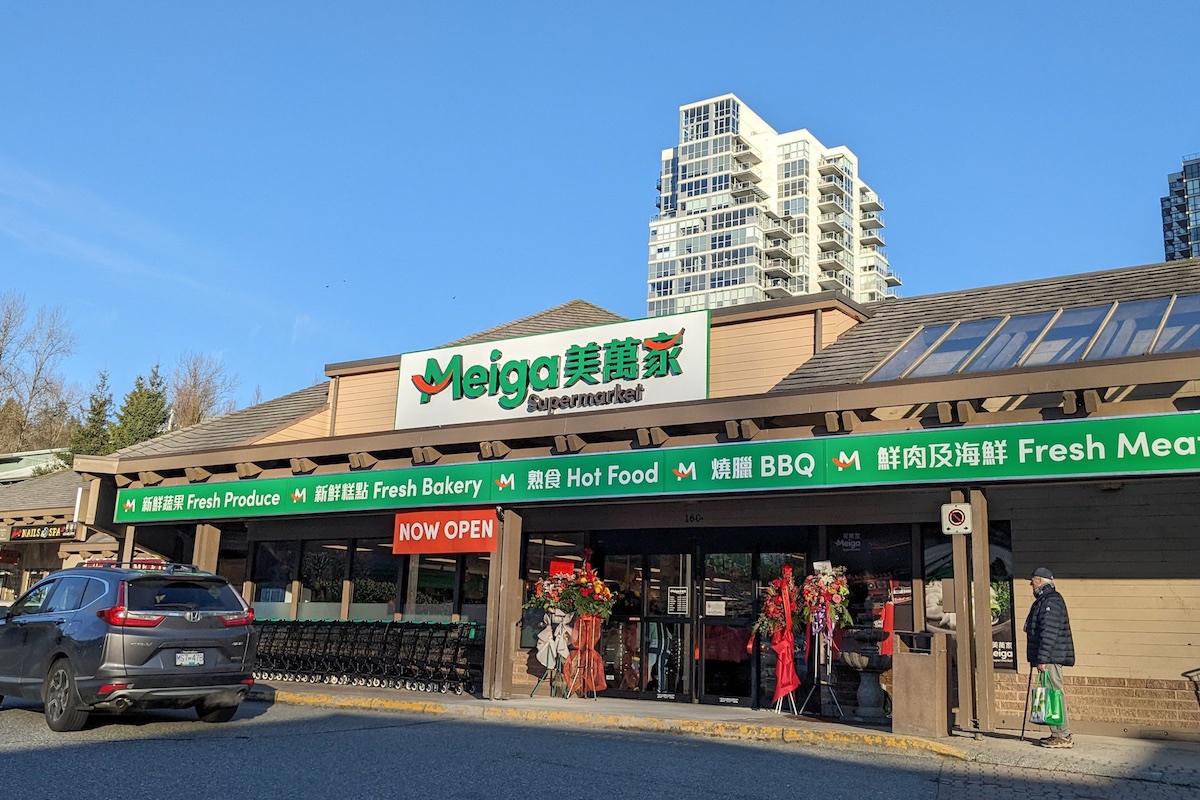
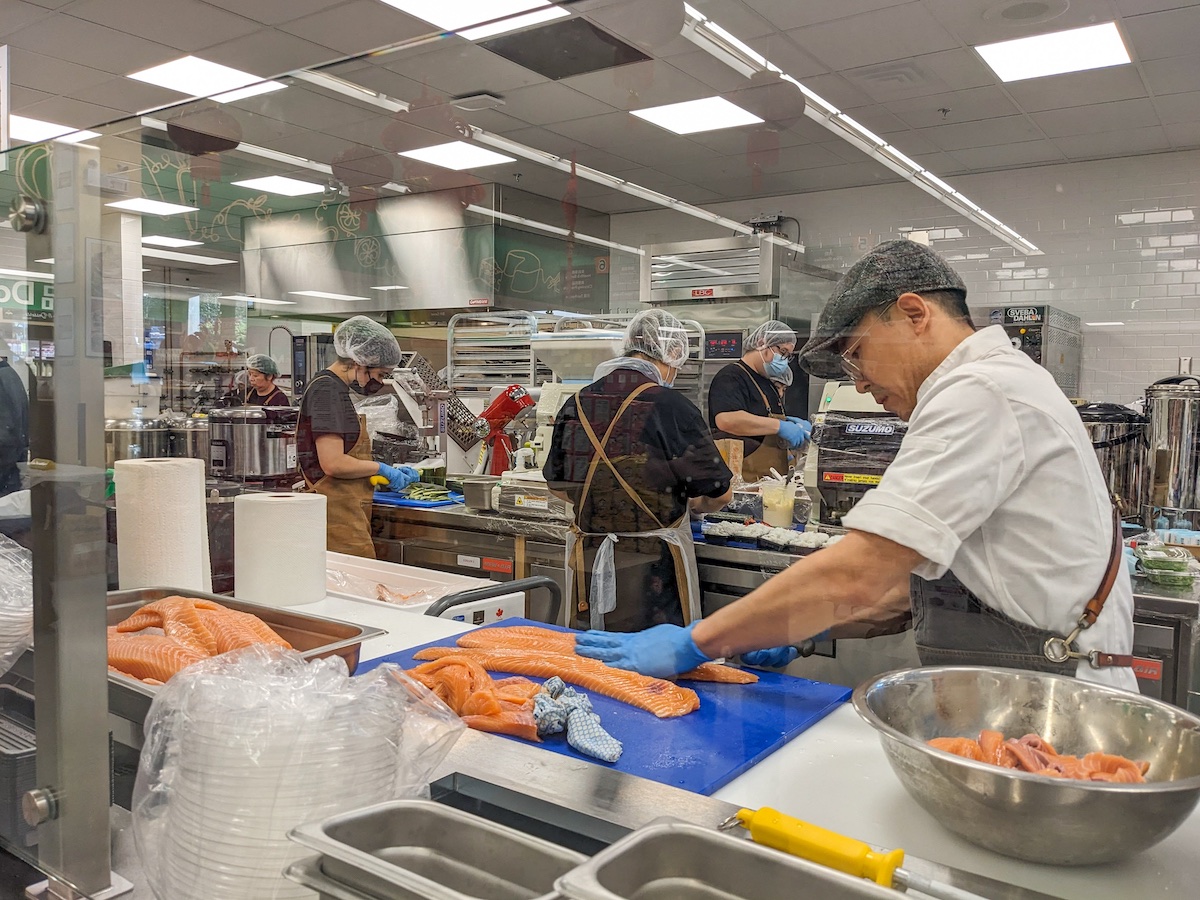
Farther up from Lougheed is Port Moody on the shores of the Burrard Inlet. Georgia Main Food Group has chosen this quieter pocket of the region to test the waters.
The company had an IGA in Newport Village — a plaza with local offerings such as a Kumon tutoring centre, medical offices, beauty salons and casual restaurants — and decided to close and reopen the supermarket as a new concept.
Any supermarket is a big deal for Port Moody, a city of 33,500, because there was only one other than the IGA: a Thrifty Foods. So when IGA closed last fall to make way for the brand new Meiga (can you spot the IGA in the name?), anticipation was high.
Meiga loosely translates to “beautiful family” in Chinese. The grand opening took place one week before the new year. At 14,000 square feet, it might be smaller than the new PriceSmart, but it’s the right size for Port Moody, with all the key departments for shopping. It’s a fun atmosphere, well stocked with grab-and-go teas, sushi, dim sum, hot meals, Hong Kong baking — and hey, a whole roast chicken like you would have found at IGA.
There are Chinese and western offerings, but also plenty of Korean products for the diaspora here, and some Southeast Asian items. The bright orange shopping bags have “Ai ya!” printed on them, a casual Chinese interjection to express surprise, blame, dismay, shock or fear. It’s sure to be a hit with Chinese Canadian kids who’ve heard their elders exclaim such a thing when they misbehaved.
It might be surprising that it’s only now that a name like H.Y. Louie is opening an Asian supermarket.
The company behind Georgia Main has been doing business in B.C. for over 120 years, founded by Hok Yat Louie during a discriminatory era for Chinese people in Canada like himself. Louie started off selling seed, fertilizer and wholesale groceries. The business flourished over the years, picking up the IGA franchise in 1955 and purchasing London Drugs in 1976. The company is still in the family, which also runs Fresh St. Market.
Meiga’s Port Moody location, says the company, is both a flagship and a testing ground. There are 4,000 products in store, twice as many as the old IGA. There are plans to expand the brand in the next three to five years.
This is admittedly a whiter part of the region, and this store is as much a comfort to some as it as a place of cultural introduction. You can tell from how local media have chosen to describe the store, with the Tri-Cities News calling the store “unfamiliar” and an “adventure.” Meanwhile the Daily Hive told readers not to worry because there are “plenty of Western options as well.”
A senior marketing director for the company says that their target market is the shopper who wants to “try new things.” Meiga staff will be trained to answer questions, host sampling events and help build customers’ comfort level with products they might not be familiar with.
On opening weekend, many Cantonese- and Mandarin-speaking customers excitedly made a run for their favourites, while white customers unfamiliar with some of the foods took the time to admire and get to know the offerings, especially at the open kitchen where chefs prepare sushi and carve out huge slabs of roasted pork belly with beautifully blistered skin.
T&T Supermarket
2929 Barnet Hwy., Unit 2740, Coquitlam
Save-On-Foods
3025 Lougheed Hwy., Unit 100, Coquitlam
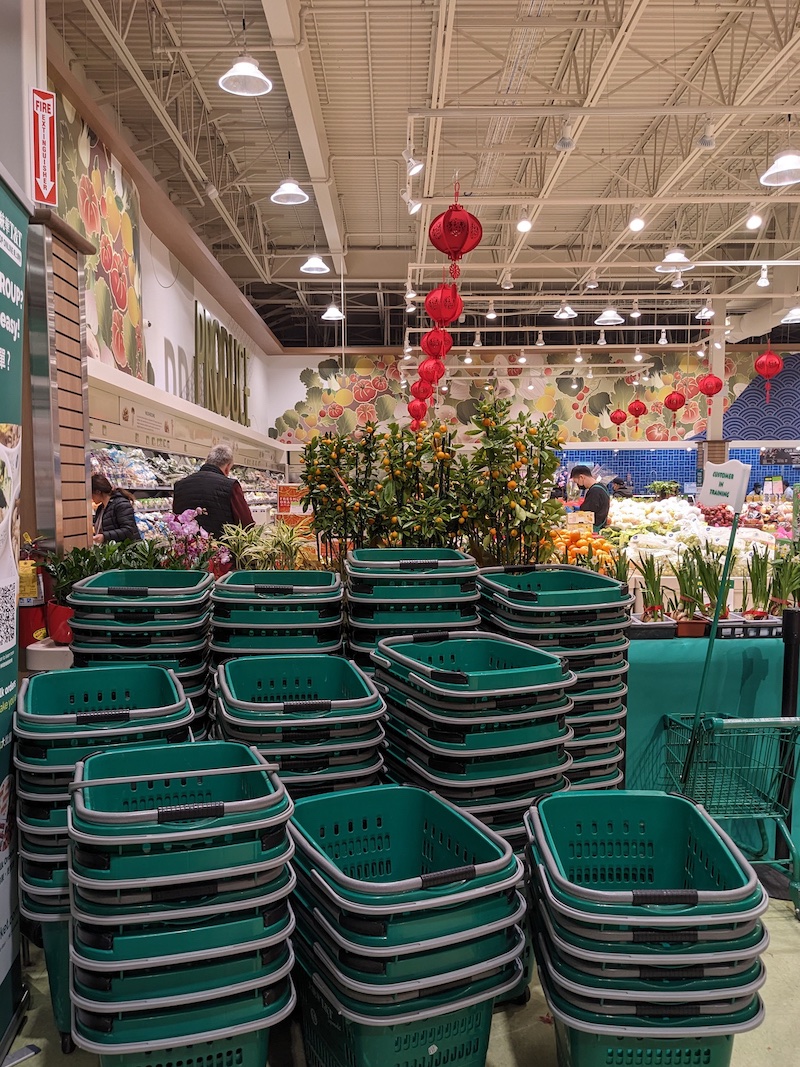
I made my way to the new Coquitlam T&T, beside the Ikea, which took over a 37,000-square-foot Home Outfitters last year. The god of wealth is there to welcome me, gifting me a red envelope with a store coupon for $10 off a $100 purchase.
The new T&Ts have been working hard to present themselves to a wider range of shoppers outside their East Asian target market, with lengthy text pasted all over their stores. They attempt to educate (“Silken tofu works well in creamy and blended foods like smoothies, desserts. It is also good for soup use”), explain (“Specialty cuts you can’t find anywhere else”), encourage (“Fall in love with crabs!”) and what even appears to be easing the fears of shoppers who might hold stigma about cleanliness in the supermarkets of the Other (“If you find any expired product in our store... we’ll give you one identical item for free”).
Coquitlam also happens to be home to a special Save-On-Foods that has been dubbed the “future of Save-On-Foods” by the Pattison Food Group. Navigating the 56,000-square-foot space is a minor workout, with a wood-fired pizza oven, a cheesemonger, a B.C. wine department, a popcorn machine, a bulk candy store, an oyster bar, a juice bar and an actual bar for beer and wine — because if there’s one place where you’ve always wanted a glass of Pinot Grigio or a pint of pale ale, it’s Save-On-Foods.
Poking around to see what East Asian offerings they have, I was impressed to see a fridge that was labelled not “ethnic” or “international dairy” but, matter-of-factly, “noodles and tofu.”
Growing up in a boom generation of the children of immigrants, my diverse group of friends and I were lucky enough to not have experienced the much-talked-about “lunchbox moment” in school, teased for bringing cultural dishes lovingly made by one’s immigrant family but considered stinky and weird by peers.
It was only when we entered whiter workforces that those dreaded moments arrived. There seemed to be two types of colleagues, either expressing disgust at our “ethnic” lunches or lurid over-fascination. The latter would kick off whitesplaining of their own global dining experiences, with notes of bravery and fetishization. It would turn a water-cooler conversation into a display of cultural plumage rather than curiosity or normalcy about what was being heated up in the microwave.
It’s a long-standing reflection of how food is othered in this country. For years, the Canadian grocery world has talked about the market in binaries: Canadian stores versus ethnic ones, Canadian consumers versus ethnic ones. This is evident in many western supermarkets, which group products by geography rather than category. So to walk these new stores and see soy and tomato sauces together, furikake beside dried basil and fish skins beside potato chips is, in its own small way, symbolic and cause for celebration.
Here amongst the aisles, special ingredients can be everyday and exciting without being exotic. The shoppers in this part of the region raised on these foods now have options closer to home. And for those who weren’t, the mingling and mainstreaming of products is helping them to make space on their kitchen tables and in their diets, one bite at a time. ![]()
Read more: Food




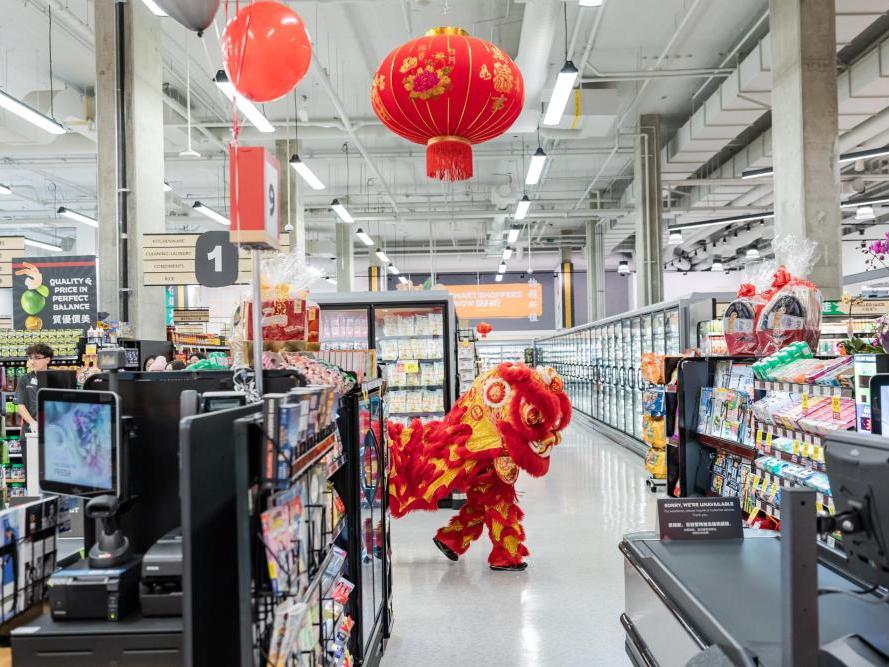












Tyee Commenting Guidelines
Comments that violate guidelines risk being deleted, and violations may result in a temporary or permanent user ban. Maintain the spirit of good conversation to stay in the discussion and be patient with moderators. Comments are reviewed regularly but not in real time.
Do:
Do not: